Key takeaways:
- Crisis support involves being present for those in distress, recognizing changes in behavior, and fostering open conversations about mental health to create a supportive community.
- Community support can reignite passion and resilience among members by sharing struggles and triumphs, reinforcing that individuals are not alone in difficult times.
- Breakdancing serves as a therapeutic outlet, allowing individuals to express emotions, engage in mindfulness, and create connections that aid in the healing process.
- Active listening, sharing personal stories, and organizing uplifting activities are effective techniques for supporting others through tough experiences.
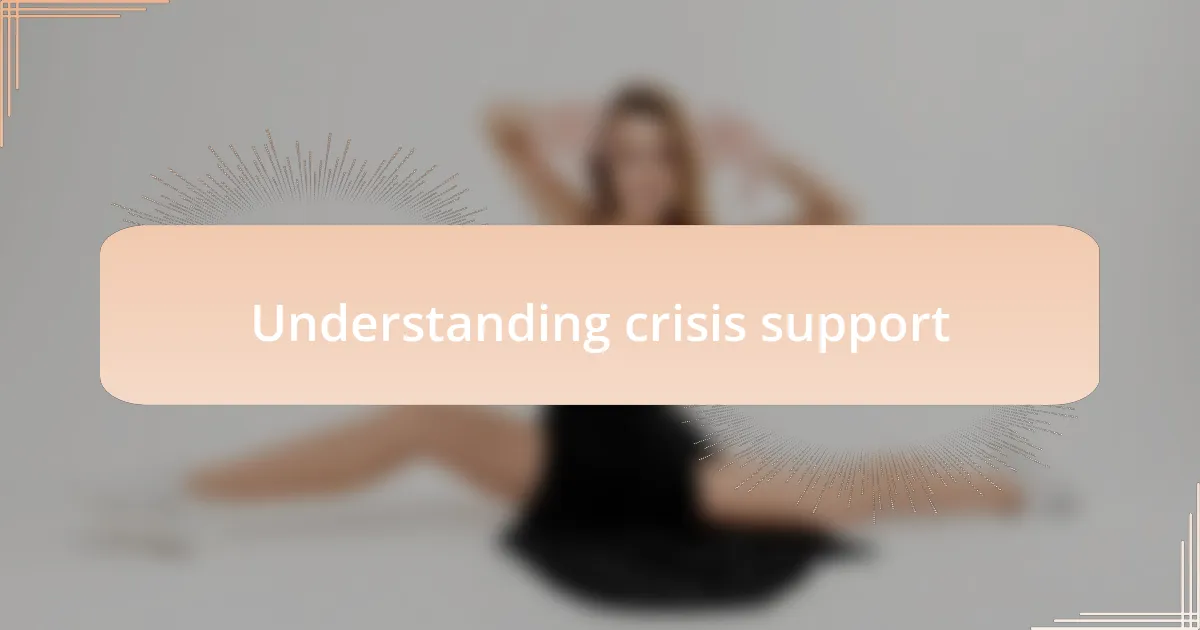
Understanding crisis support
Crisis support is fundamentally about being there for someone when they feel most vulnerable. I remember a day when a fellow dancer felt overwhelmed by personal pressures, and simply listening without judgment made a world of difference. It’s astounding how just being present can shift someone’s mindset and help them see a glimmer of hope.
Understanding crisis support goes beyond just offering words of comfort; it’s about recognizing the signs that someone is in distress. Have you ever noticed a friend who suddenly stops dancing or isolates themselves? I’ve found that being vigilant about these changes can help us intervene before a feeling of hopelessness sets in—and sometimes, a simple check-in can reignite their passion.
The relationship between crisis support and our community is deeply intertwined. When we engage in open conversations about mental health, we foster an environment where dancers feel safe to express their struggles. Reflecting on my experience, it’s clear that we can create a network of support through empathy and shared experiences, allowing us all to feel more connected and less alone in difficult times.
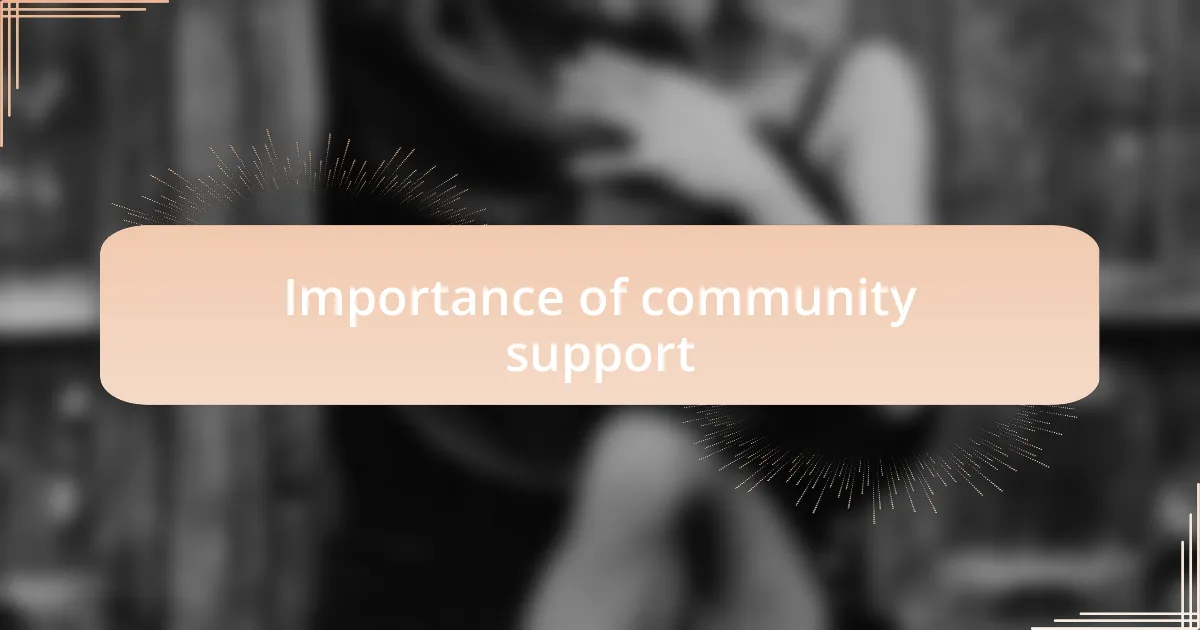
Importance of community support
Having a strong community means that every member knows they have a safety net to fall back on during tough times. I recall when a close friend in the dance scene faced a major setback and felt like giving up. The love and encouragement from our crew not only lifted their spirits but also sparked a determination to push through. Isn’t it incredible how the support of just a few trusted individuals can reignite someone’s passion for dance?
Community support provides a platform for sharing struggles and triumphs alike. I remember organizing a small gathering where we opened up about our mental health challenges. The vulnerability that was shared fostered understanding and solidarity among us dancers. Have you ever felt empowered by someone else’s story? That night, I realized that simply sharing our battles could transform our collective experience into something empowering.
Moreover, the benefits of community support extend beyond individual struggles—it strengthens our entire scene. When we rally around each other, we cultivate resilience not only within ourselves but also within the community as a whole. It’s awe-inspiring to witness how a united front can create a positive ripple effect, inspiring others to reach out and support one another. In moments of crisis, we remember that we are never alone; our community stands strong, ready to uplift us.
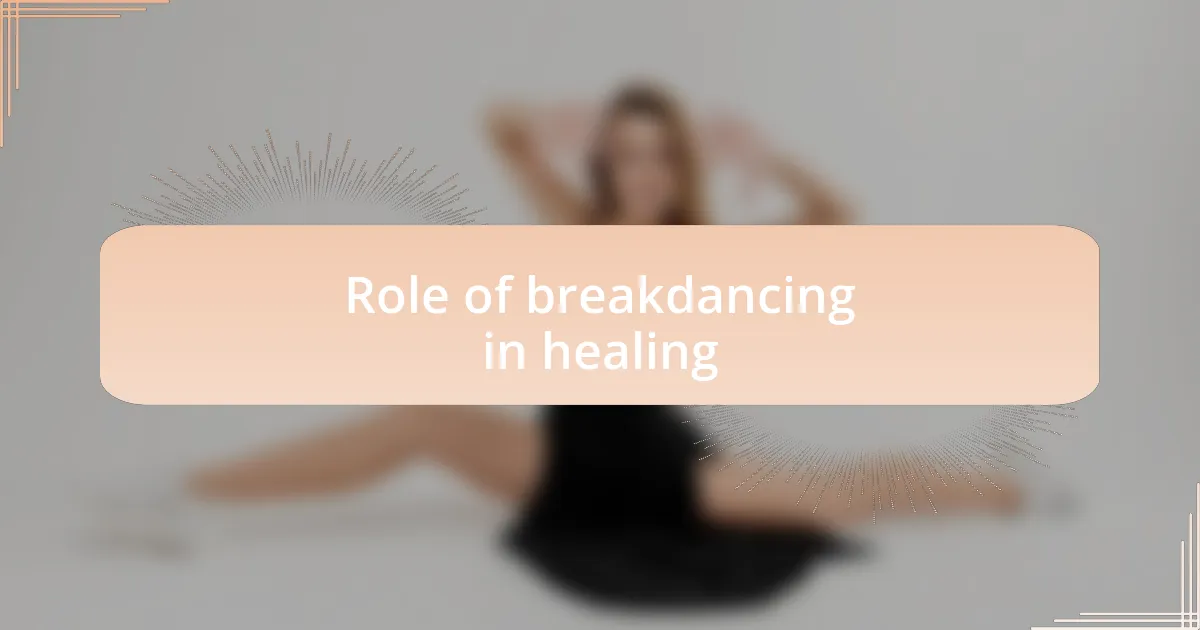
Role of breakdancing in healing
Breakdancing can be a powerful outlet for navigating emotional turbulence. I recall hitting the dance floor after a particularly rough week, feeling the rhythm pulse through me, allowing me to release pent-up frustration. Isn’t it fascinating how a single move, like an effortless windmill, can translate your struggles into something beautiful?
The act of expressing oneself through movement not only provides a distraction from life’s stressors, but it also encourages mindfulness. When I’m immersed in a breaking session, everything else fades away. I’ve experienced moments where concentrating on a challenging freeze has forced me to be present, allowing my mind the space to heal. Have you ever noticed how losing yourself in something you love can feel like a mini-therapy session?
Moreover, as I share my dance journey with fellow breakdancers, I find that the connection deepens my understanding of my own healing process. I once participated in a jam where stories of overcoming adversity flowed as freely as the beats. By sharing experiences, our movements became a collective healing ritual, reminding me that we are all in this together. Isn’t it empowering to realize that through dance, we can not only heal ourselves but also lift each other up?
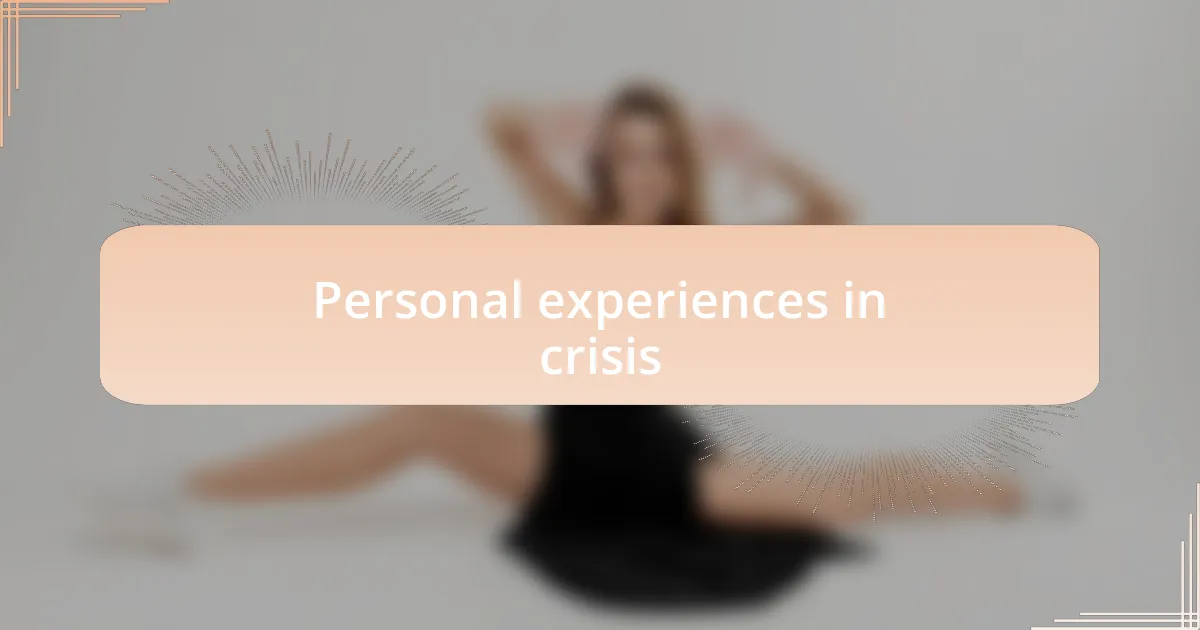
Personal experiences in crisis
There were moments in my life when the weight of stress felt unbearable. I remember standing in front of the mirror, feeling overwhelmed, and then pushing myself to battle through my insecurities with dance. The moment I hit the floor in a practice session, I could literally feel the tension fade away with every spin; it was as if the music was lifting a heavy cloak off my shoulders.
Once, during a particularly tough summer, I found solace in breakdancing with a small group of friends who shared similar challenges. We created our own little circle where the atmosphere felt safe enough to express not just our movements, but also our fears. Those sessions became a refuge—an interruption to our struggles—where we tossed aside words and let our bodies do the talking. Have you ever felt that kind of relief in a space where you can be yourself?
In times of crisis, I’ve often turned to the community around me. There was an impromptu battle in a local park where, despite the competition, everyone supported one another with cheering and nods of encouragement. The energy was infectious; it reminded me that even in hard times, camaraderie is a powerful source of strength. Is there a better feeling than knowing you’re not alone in your fight?
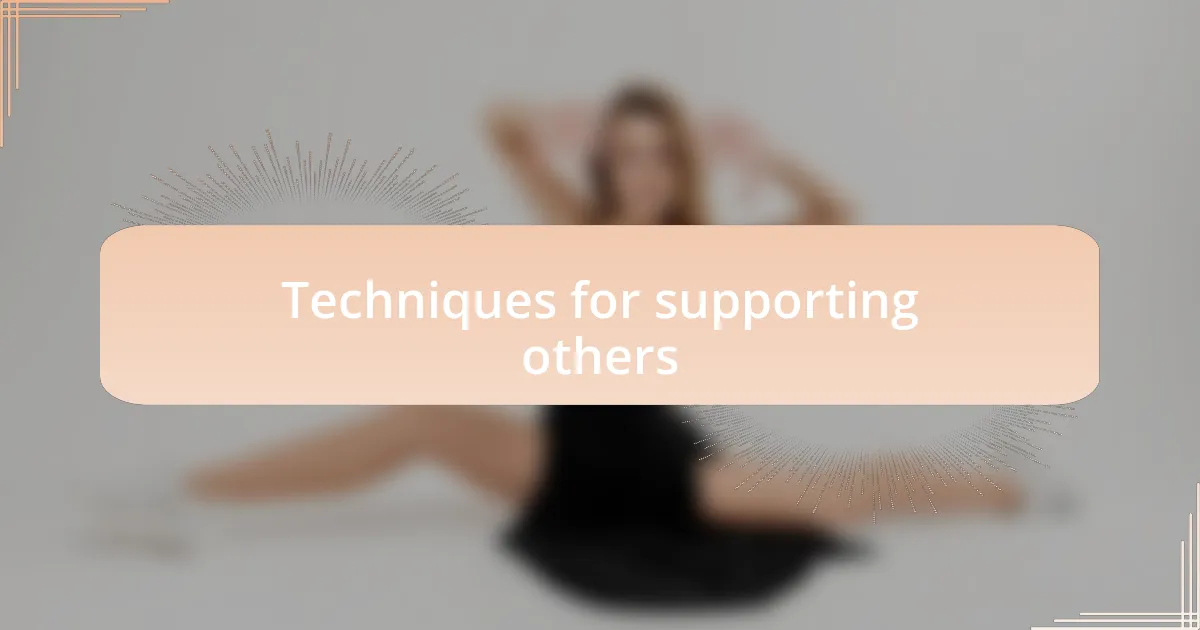
Techniques for supporting others
When supporting others, I’ve found that actively listening can be one of the most powerful tools. I remember a time when a friend reached out after a rough week; instead of jumping in with advice, I simply sat with him and let him share his feelings. By giving him that space, I noticed how much lighter he felt just by being heard. Have you ever experienced that moment when someone really listens and it feels like a weight has lifted?
Another technique that works for me is sharing personal stories of struggle. I recall a rehearsal where I opened up about a recent setback in my dance journey. This vulnerability encouraged others to share their challenges too, fostering a deeper connection among us. I’ve noticed that sometimes, just knowing someone else has faced similar battles can ignite hope. Is there a story you can share that might help someone feel less isolated?
Engaging in uplifting activities has also proven effective. I often organize dance sessions that blend practice with relaxation, creating an encouraging environment. It’s a combination of movement and laughter, and it can transform the mood instantly. When we all dance together, it becomes a celebration of resilience and support. What kinds of activities do you think could bring joy to someone going through a tough time?
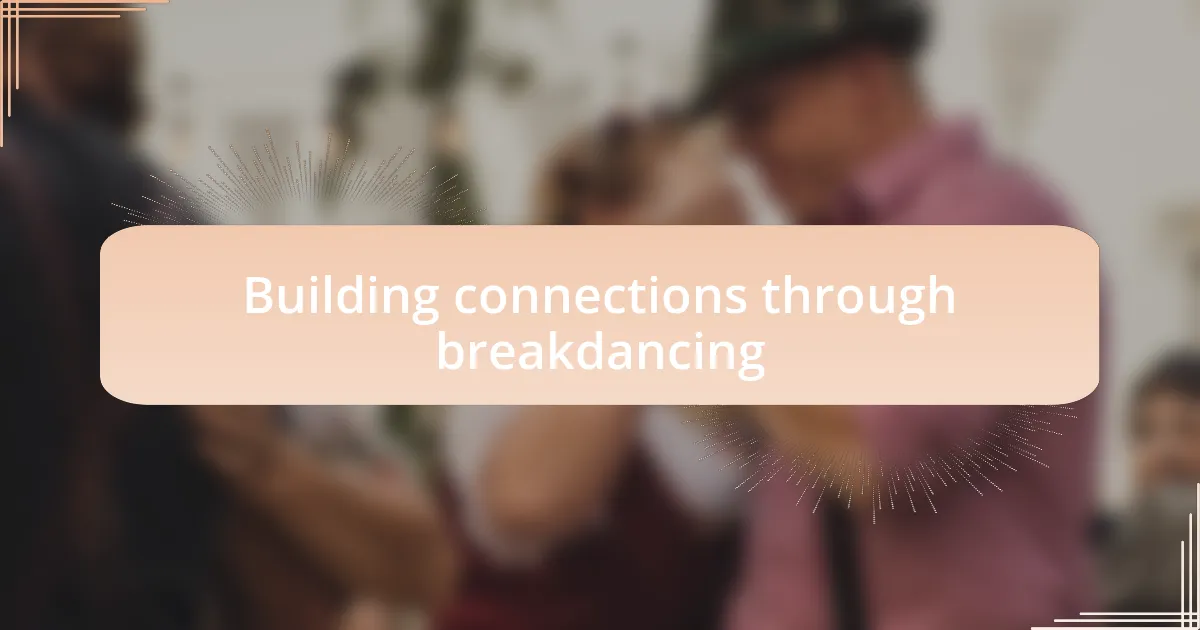
Building connections through breakdancing
When I step onto the dance floor, I often find a sense of unity that’s hard to describe. One night, during a local jam, I started doing a spontaneous move and noticed others jump in, mirroring my energy. In that moment, I felt a surge of connection; we were all just individuals lost in our own lives, but on that floor, we were part of something bigger. Have you ever felt that collective spirit in a space where everyone is just dancing for joy?
Breakdancing allows us to create bonds that go beyond the music and moves. I vividly remember a workshop where participants were from different backgrounds, yet as we shared tips and tricks, the barriers faded. Their smiles, laughter, and the way we cheered each other on made me realize that dance is a universal language. Isn’t it amazing how a shared passion can build friendships that feel like family?
There’s something transformative about sharing the same struggle of mastering a trick or perfecting a routine. I’ll never forget when I battled my own insecurities at a competition, only to find support from fellow dancers who encouraged me before I stepped on stage. At that moment, I realized that our struggles in dance reflect the challenges we face in life. How can we better support each other in these moments, both on and off the floor?